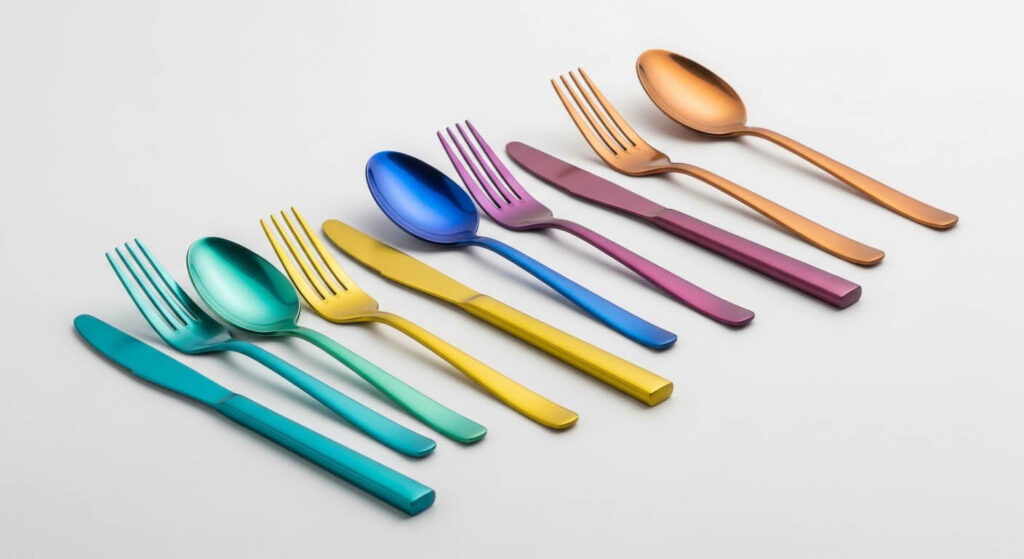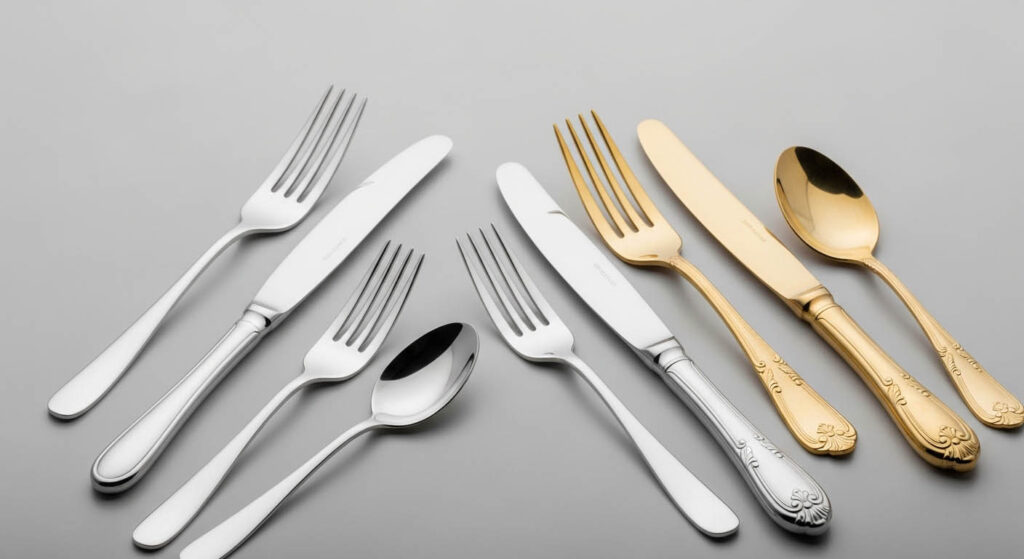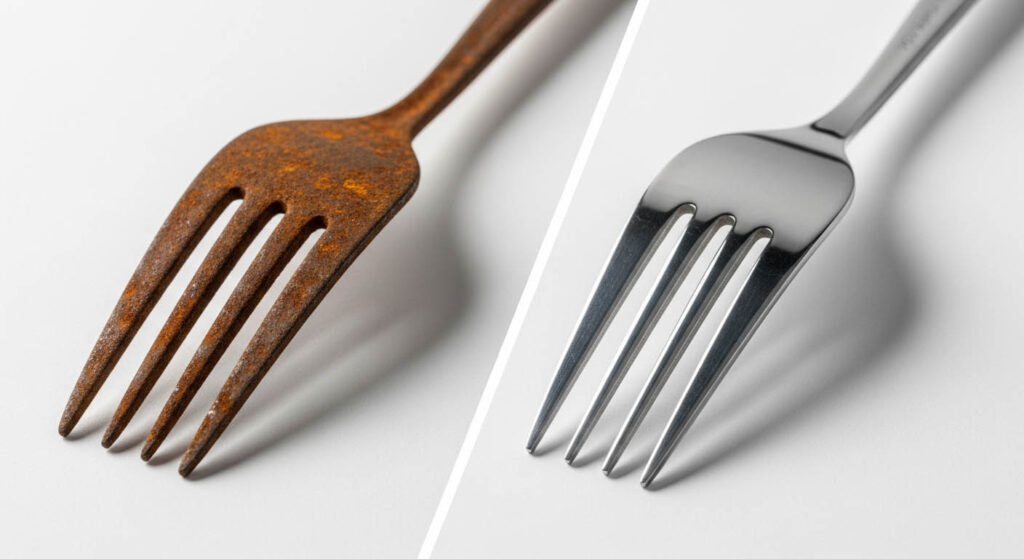What will be the trend of stainless steel cutlery in 2025?
Planning your 2025 product line feels risky. Guessing wrong on trends means dead inventory and lost money. It's a huge gamble for your brand.
The 2025 trend combines minimalist and vintage designs with bold colors from PVD1 coatings. Consumers are also demanding sustainable, high-quality 18/10 steel. Functionality is key, with sets adapting to less formal, global dining habits.

It's an exciting forecast! I discuss these trends daily with buyers like Jacky from the U.S. He's not just buying for today; he's planning two years ahead for a massive brand. To really understand where we're going, we need to know how we got here. Why did stainless steel become king in the first place? Answering these basic questions reveals the foundation upon which all future trends are built. Let's look at the history and solid advantages that make stainless steel the perfect canvas for the future.
When did stainless steel cutlery become popular?
Think of old movies where everyone uses silver. Now, steel is everywhere. You wonder how that change happened so fast, it feels like it has always been here.
Stainless steel cutlery became popular after World War II, exploding in the 1950s and 60s. The rise of the middle class, dishwasher technology, and the desire for low-maintenance, modern living made it the practical and affordable choice over traditional, high-maintenance silverware.

Before the war, if you had a nice set of cutlery, it was almost certainly silver or silver-plated. It was a status symbol. I remember my grandmother telling me about the hours she spent polishing the family silver. After the war, everything changed. We saw a huge boom in suburban living. Families wanted modern conveniences and less formal lifestyles. The invention of the automatic dishwasher was a huge catalyst. You can't put most silver in a dishwasher, but stainless steel was perfect for it. Manufacturers in Sheffield, England, and Solingen, Germany, who had been making steel for weapons, pivoted to making high-quality domestic goods. They marketed it as the modern, carefree choice. It was shiny, it didn't need polishing, and it was tough enough for daily use. It perfectly captured the spirit of the post-war era.
Why are stainless steel utensils very popular nowadays?
You know it's popular, but you're surrounded by it. Why, specifically, did this one material beat all others for everyday use so completely? It seems too simple.
Stainless steel is popular today because it offers an unbeatable combination of durability, hygiene, affordability, and style. It doesn't rust, bend, or stain easily, is dishwasher safe, and provides a neutral base for endless design possibilities.

I explain to every new buyer that stainless steel hits the four key targets of a perfect material. It's the reason it remains unbeaten for mass-market and high-end use alike.
- Strength and Durability: This stuff is tough. It can be dropped, scraped, and put through a commercial dishwasher thousands of times without bending or breaking. This is why hotels and restaurants rely on it.
- Hygiene and Safety: The surface of stainless steel is non-porous. This means there are no tiny holes for bacteria to hide in. It doesn't react with acids or salts in food, so it never changes the taste.
- Low Maintenance: This is its biggest selling point for home users. You use it, you wash it, you put it away. It doesn't tarnish like silver or absorb stains like wood.
- Design Versatility: This is why it remains relevant for trends. It’s a perfect canvas. We can polish it to a mirror shine, brush it for a satin look, or use PVD coating to make it black, gold, or even rainbow-colored.
How many years will stainless steel last?
You invest in a good set of cutlery. You expect it to last, but will it truly last a lifetime? Or will you be replacing it in 10 years?
A quality set of stainless steel flatware, particularly 18/10 or 18/8 grade2, can easily last a lifetime and can even be passed down through generations. Its durability means it resists wear and tear from daily use and washing. Cheaper grades may show wear sooner.

This isn't just a marketing claim; it's a material fact. The longevity comes from the chromium in the steel3. It forms a passive, invisible layer that protects the iron from rusting. If you scratch it, this layer instantly "heals" itself as long as oxygen is present. That's why even after years of use, it resists corrosion. Jacky once showed me a fork from a big hotel chain he supplies. He told me it had been in constant service for over 20 years. It had some minor surface scratches, but it was still perfectly straight, shiny, and completely free of rust. The reality is, you are far more likely to lose pieces of your flatware set over the years than you are to have one wear out. For a high-grade 18/10 set, its lifespan is essentially indefinite with normal care.
Why is cutlery made of stainless steel rather than iron?
Steel comes from iron, so why not just use pure iron? It seems simpler. You wonder what makes "stainless steel" so special compared to its parent metal.
Cutlery is made from stainless steel instead of raw iron primarily to prevent rust. Iron oxidizes very quickly when exposed to water and air, staining food and tasting metallic. The addition of chromium to iron creates stainless steel, which forms a protective, rust-resistant layer.

Using pure iron to make a fork would be a disaster. Imagine leaving an iron nail in a glass of water overnight. By morning, it would be covered in rough, orange rust. Now imagine that happening to your fork after one wash. The rust would flake off onto your food, it would taste awful and metallic, and the rough surface would be impossible to properly clean. It would be completely unhygienic and unusable.
The discovery of stainless steel in 1913 by Harry Brearley was revolutionary. He found that by adding about 13% or more of the element chromium to molten iron, something amazing happened. The chromium atoms react with oxygen in the air to create a microscopic, tough, and invisible "skin" on the surface of the steel. I like to tell people it's like the steel is wearing a permanent, self-healing raincoat. This raincoat, called the passive layer, is what stops rust in its tracks and makes stainless steel the perfect, safe material for coming into contact with our food.
Conclusion
Looking to 2025, expect colorful, textured cutlery. Trends merge minimalism and vintage styles, while consumers demand sustainable, high-quality 18/10 steel, valuing personal expression over traditional sets.
-
Exploring this link will provide insights into PVD coatings' advantages and their role in modern design trends. ↩
-
Understanding the differences between these grades can help you choose the best quality flatware for your needs. ↩
-
Understanding chromium's role can enhance your knowledge of steel's longevity and corrosion resistance. ↩
